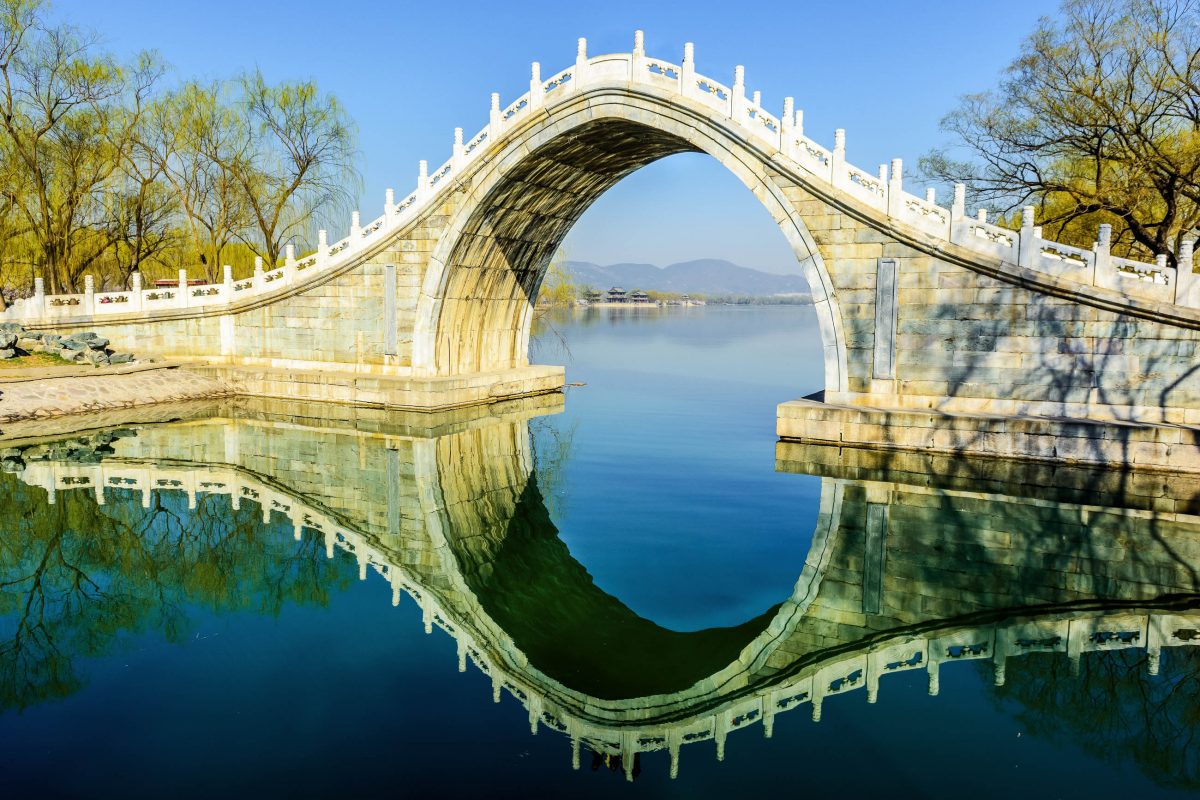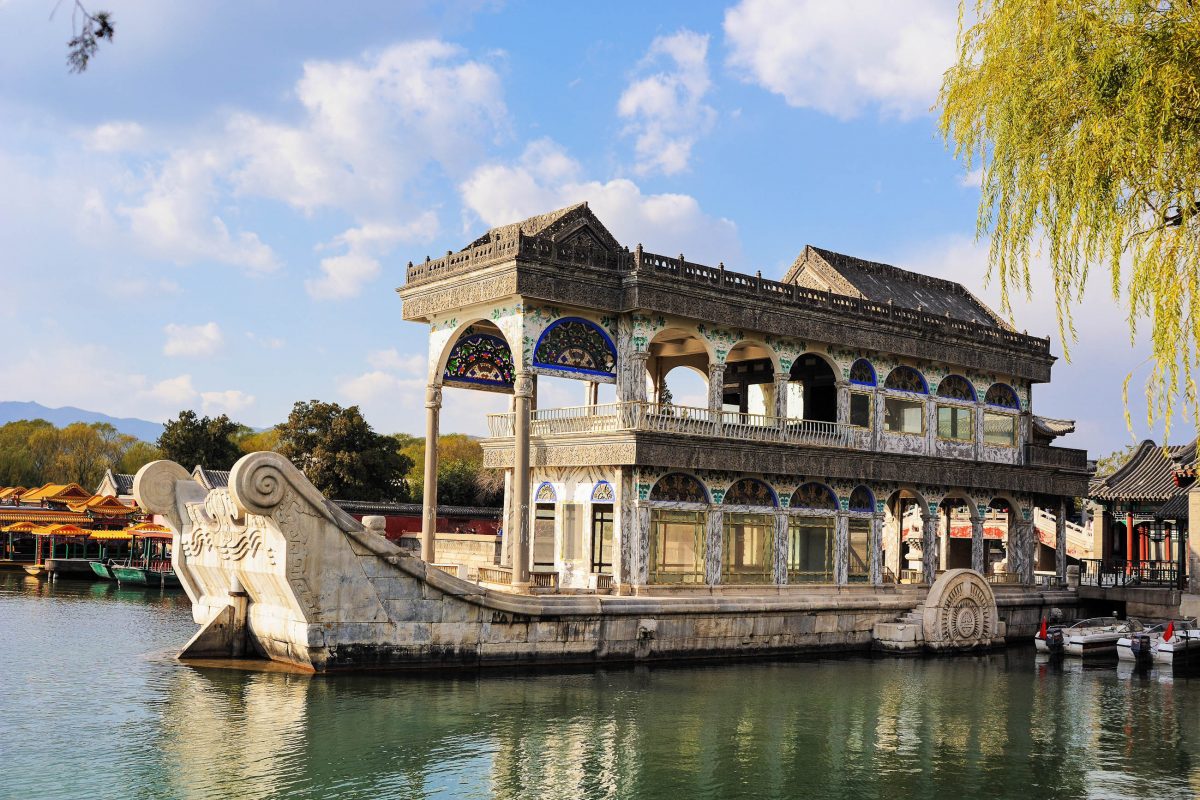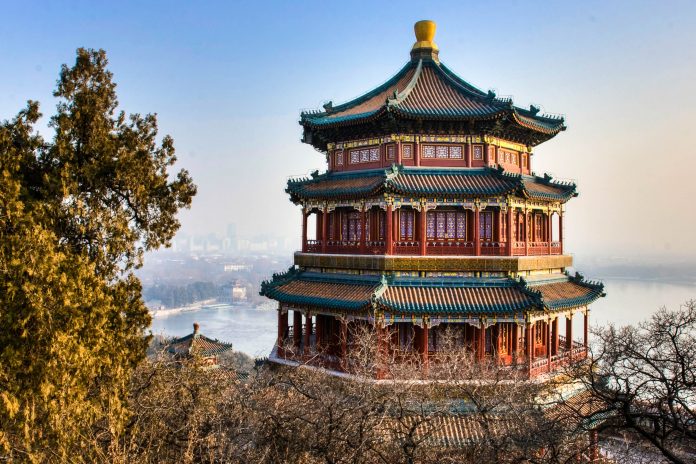Der kaiserliche Sommerpalast in Beijing gilt als Höhepunkt der chinesischen Architektur und Landschaftsgestaltung. Erbaut im 18. Jahrhundert wurde er oftmals zerstört und wieder aufgebaut. Heute stehen seine Gärten, Pavillons und der angrenzende Kunming-See für Erholung, Harmonie und Schönheit.
Die Bezeichnung „Kaiserlicher Sommerpalast“ vermittelt eher ein untertriebenes Bild des gigantischen Komplexes in der chinesischen Hauptstadt Peking. Das gewaltige Kunstwerk aus Bauten und Gärten zählt zu unseren Top 10 Sehenswürdigkeiten von China.
Der Kaiserliche Sommerpalast liegt auf einem Gelände von knapp 3 Quadratkilometern im Nordwesten Pekings zwischen den Ufern des Kunming Sees, der das weibliche Yin repräsentiert, und dem für das männliche Yang stehenden Hügel der Langlebigkeit.
Kulturell ist der Sommerpalast so wertvoll, da er die Philosophie und Umsetzung der einzigartigen chinesischen Kunst des Garten-Designs optimal darstellt. Die chinesische Lebensart kann zwischen den Meisterwerken chinesischer Architektur und Landschaftsgestaltung 1:1 nachvollzogen werden. Seit 1998 zählt er zu den Weltkulturerbestätten der UNESCO.
Inhaltsverzeichnis
BILDER: Kaiserlicher Sommerpalast in Beijing (Peking)
Fotogalerie: Kaiserlicher Sommerpalast in Peking
Errichtung des Kaiserlichen Sommerpalastes in Peking
Kaiser Qianlong ließ um 1750 den kaiserlichen Sommerpalast für seine Mutter zum 60. Geburtstag errichten. In den Jahren bis 1764 entstanden kunstvoll angelegte Gärten, großzügige Wohnhäuser, malerische Bachläufe, märchenhafte Laubengänge, beeindruckende Brücken und prunkvolle Pagoden.
Der Garten war in drei Bereiche geteilt: ein Teil galt der Politik und der Verwaltung, einer den Privaträumlichkeiten und einer der Erholung und Entspannung. Die Wasserwege des Gartens führten bis in Pekings Zentrum zum fast 20km entfernten Kaiserpalast, da die Kaiserfamilie immer per Boot anreiste.
Wechsel aus Zerstörung und Wiederaufbau

Knapp 100 Jahre später wurde er gemeinsam mit dem nur wenige hundert Meter weiter westlich befindlichen alten Sommerpalast im Opium-Krieg beinahe vollständig zerstört. Zwischen 1886 und 1865 ließ ihn Kaiser Guangxu für die „Kaiserinwitwe“ Cixi, eine Nebenfrau des Kaisers Xianfeng, wieder aufbauen. Zu dieser Zeit erhielt er auch erstmalig den Namen „Sommerpalast“, da er zum bevorzugten Aufenthaltsort der Kaiserfamilie während der heißen Sommermonate avanciert war.
Bei den Chinesen hieß er jedoch nach wie vor „Garten des Friedens und der Harmonie im Alter“. Der alte Sommerpalast daneben wurde nicht wiederhergestellt, von ihm sind heute nur mehr einige Ruinen zu sehen, die auf die ursprüngliche Pracht schließen lassen. Eine weitere Zerstörung inklusive Wiederaufbau erfolgte im Zuge der Niederschlagung des Boxeraufstandes 1900.
Für die Öffentlichkeit zugänglich wurden die Gärten erst 1924 nachdem der letzte Kaiser von China vertrieben worden war und mittlerweile sind auch die anfangs exorbitanten Eintrittspreise leistbar geworden.
Besuch des Kaiserlichen Sommerpalastes in Peking

Obwohl der Kaiserliche Palast und seine Gärten zu den Hauptattraktionen von Peking zählen, wird dort kaum Tourismus betrieben. Der Eintritt ist mit ein paar Euro verschwindend gering und es gibt auch keine marktschreierischen Händler, die die Besucher belästigen.
Um den fantastischen Garten in seiner ganzen idyllischen Pracht zu genießen, sollte man sich einen ganzen Tag Zeit nehmen. Langweilig wird dem Auge bei der Vielzahl an architektonischen und landschaftlichen Wundern garantiert nicht.
Sehenswürdigkeiten im Kaiserlichen Sommerpalast in Peking
- MonumentalenBauten und andere Sehenswürdigkeiten gibt es im kaiserlichen Sommerpalast in unglaublicher Vielfalt
- Das Osttor, durch das die ausländischen Diplomaten die Halle des Wohlwollens und der Langlebigkeit betraten hinterließ gleich bei deren Ankunft einen gewaltigen Eindruck
- Die Pagode des buddhistischen Wohlgeruchs, mit 41 Metern eine der höchsten traditionellen Holzbauten in China
- Der 728 Meter lange Wandelgang, mit mehreren Pavillons und 273 Säulenpaaren, dazwischen mehr als 8.000 Gemälden mit mythologischen Szenen, Landschafts- und Vogelbildnissen, eine einzigartige Symbiose aus Architektur und Kunstgalerie

- Die kolossale Siebzehn-Bogen-Brücke, die die Nanhu-Insel mit dem Seeufer verbindet, die kunstvoll geschwungene Jadeband-Brücke oder die unscheinbare versteckte Brücke am Kunming-See
- Die Halle der Jadewellen, in der Kaiser Guangxu seine Arbeits- und Schlafgemächer hatte, später wurde er hier von seiner Tante Kaiserin Cixi unter einem Vorwand inhaftiert
- Die Halle der Freude und der Langlebigkeit beherbergte die Wohnräume der Kaiserin Cixi, die Halle Yiyun die der Konkubinen von Guangxu

- Das Marmorboot Qingyanfang, eine wahrhaft exquisite Aussichtsplattform auf dem Kunming-See und Cixis witziges unbewegliches Pendant zur chinesischen Marine, für die einige Geldmittel, die in den Wiederaufbau des Parks flossen, eigentlich geplant waren
- Der bronzene Pavillon der Kostbaren Wolken sieht aus als wäre er aus Holz, wiegt jedoch 200 Tonnen
- Der Garten der Tugend und der Harmonie beinhaltet ein Theater und die Halle der Erheiterung
Frauenherrschaft
In der Halle des Wohlwollens und der Langlebigkeit empfing Kaiser Guangxu ausländische Diplomaten und wickelte mit ihnen Staatsgeschäfte ab – dabei unter ständiger Beobachtung der Kaiserin Cixi, die sich hinter einem Wandschirm verbarg und in China damals tatsächlich die Fäden der Regierung zog.





